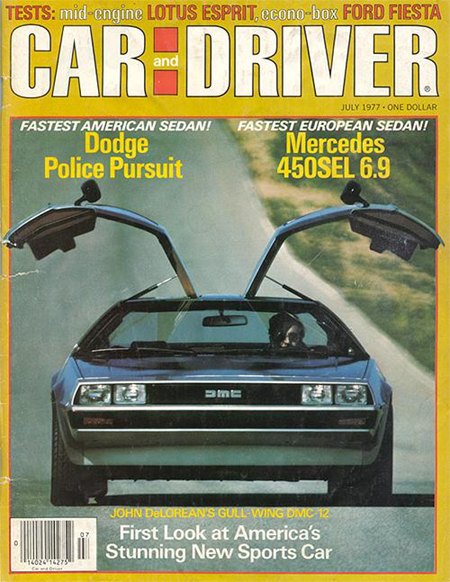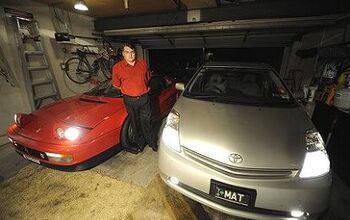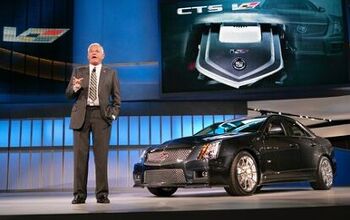Car and Driver RIP
When I first picked up Car and Driver’s (C&D) fateful December 2006 issue, I was convinced that the splashy, graphics-heavy revamp sounded the death knell for my favorite buff book. But the resulting reader backlash was so loud I felt sure Ann Arbor’s finest would be scared straight. A plaintive apology followed the editor’s arrogant dismissal of the reader revolt. C&D seemed poised for a revival. Nope. The October 2007 issue isn’t just the lowest point in the mag’s inexorable descent; it’s a dive below the limits of acceptability.
The buff books’ decline is inversely proportionate to digital media’s rise. Why fork over good money for a magazine subscription, endure two-month old editorials and wade through dozens of ads when the web provides fresh, instant and less ad-intrusive content for free? For the mags, there's an obvious answer: an upmarket re-imagining of the paper-based genre, like the UK’s elegant, ballsy evo magazine.
No such luck. Like The Big 2.8, even a precipitous decline in market share and profits hasn’t convinced the powers-that-be at Car and Driver, Road & Track and Motor Trend that there's a pressing need for radical change. The buff book Old Guard eschews brave revolution in favor of gentle evolution. Even worse, they throw poisoned fruit at the web-slingers– even as these digital vanguards saw away the branch upon which they sit.
In C&D’s October review of the Mercedes-Benz CL63 AMG, the editors make their opinion of webheads– their own no less– abundantly clear. “When [the CL63] arrived on Hogback Road, it caused all the web-site interns to run outside and gawk… The rest of the staff wasn’t easily beguiled by the CL63… because the CL600 can do everything the CL63 does without the fanfare and flamboyance of the AMG car.”
Yep, that’s us: tacky, juvenile, given to fleeting fads. But where is the cold-eyed, experience-hardened objectivity of these experts in their own evaluations? Well, as concerns the CL63 vs. CL600 debate, here’s how the pros’ prose goes: “You can’t really go wrong with either, so which would you rather live with?” Thanks, Motor Trend.
On the next page, we see more journalistic brilliance, this time applied to the Mercedes-Benz SLR McLaren Roadster: “…the SLR’s dynamics are hard to love… It’s hard to be smooth with this car. But whaddaya want for a half-million bucks?” I’ll tell you what I want for twelve bucks a year: the occasional negative comment about a car that deserves it.
You won’t find any in the October issue’s “Short Takes.” The executive summary of the Subaru Tribeca’s driving dynamics: “Its fun-to-drive index is low, but its road manners are almost beyond reproach.” And there I was thinking that a low fun-to-drive index equaled middle-of-the-road road manners. The closing paragraph of the Taurus write-up compares the refreshed Five Hundred to the 1985 Taurus, rather than the new car’s current competitors.
The Buick Enclave review quotes a 0 to 60 time of nine seconds, 14 mpg fuel economy and an as-tested price of $43,950. C&D’s conclusion? The Enclave “undercuts the pricing of key competitors: Acura MDX, Lexus RX350, Volvo XC90. And the Enclave measures up well against any of them.” Uh-huh. The intro to that piece damns a New York Times writer for telling GM to build vehicles that people “actually want to buy;” a “dazzling insight,” says C&D.
C&D’s “Road Test” is a format that usually allows more candor. In this case, the mag reviews the new Volvo C30– a car aimed straight at the MINI– without once describing how it handles in the twisties. “The steering zeroes in on ‘straight down the road’ when you cruise,” they assure us. “Expect understeer,” they elaborate, kind of. Their “Verdict:” it’s “a Swede to be seen with.” As for the Audi S5: “What the Audi brings to the party is a real sense of style… isn’t that what coupes are all about?” Um… what do you think?
Methinks C&D’s increasingly bitter tone stems from the passionate, seasoned, talented auto writers’ need to sacrifice every last shred of journalistic integrity on the altar of diminishing ad revenue. They can’t possibly enjoy it.
To their credit, the October issue does include a well-written comparison of the Dodge Viper and Corvette Z06. It seems clear that as long as the iron involved is sufficiently unattainable to the mere motoring public, C&D can muster its mojo and call a spade a spade.
But that’s not enough to save a magazine that’s gotten too big for its britches. If a car mag can’t be bothered to spill the beans on the sort of cars real-world enthusiasts drive– you know, the lowly souls that might write for a “web-site”– it simply can’t expect to survive.
Brando got fat. Jacko got crazy. And America’s best buff book has lost it. Good night, C&D. Thanks for the memories.
More by P.J. McCombs
Latest Car Reviews
Read moreLatest Product Reviews
Read moreRecent Comments
- Teddyc73 Doesn't matter, out of control Democrats will still do everything they can to force us to drive them.
- Teddyc73 Look at that dreary lifeless color scheme. The dull grey and black wheels and trim is infecting the auto world like a disease. Americans are living in grey houses with grey interiors driving look a like boring grey cars with black interiors and working in grey buildings with grey interiors. America is turning into a living black and white movie.
- Jalop1991 take longer than expected.Uh-huh. Gotcha. Next step: acknowledging that the fantasies of 2020 were indeed fantasies, and "longer than expected" is 2024 code word for "not gonna happen at all".But we can't actually say that, right? It's like COVID. You remember that, don't you? That thing that was going to kill the entire planet unless you all were good little boys and girls and strapped yourself into your living room and never left, just like the government told you to do. That thing you're now completely ignoring, and will now deny publicly that you ever agreed with the government about.Take your "EV-only as of 2025" cards from 2020 and put them in the same file with your COVID shot cards.
- Jalop1991 Every state. - Alex Roy
- CanadaCraig My 2006 300C SRT8 weighs 4,100 lbs. The all-new 2024 Dodge Charge EV weighs 5,800 lbs. Would it not be fair to assume that in an accident the vehicles these new Chargers hit will suffer more damage? And perhaps kill more people?


































Comments
Join the conversation
Ultimately, it is really about more than whether or not management - meaning Hachette-Filipacchi - leans on Csaba Csere to cut costs and raise advertising revenues; that's just one factor. The overarching issue is that a generation has grown up so used to electronic media, delivered on various screens of various sizes, that that generation is not willing to read through an essay of 2,500 to 3,000 words. Essays such as that were what made Car and Driver one of the best magazines in the country. And the time period in which those essays flourished were when the late Leon Mandel was editor. As someone with a journalism degree from Cornell, he operated on a different level that the current editor, whose background is that of an engineer, who came from a major corporation (Ford). While I never met Leon, only talked to him on the phone once and communicated with him by e-mail in the last two years of his life, my impression is that he was not a "company man," to borrow a phrase hardly anyone uses anymore. And he attracted other people who were free thinkers, such as Brock Yates, the late Warren Weith, Bruce McCall and Jean Shepherd (who was known to many people outside of auto magazine readers, for his radio essays and essay about wanting a rifle for Christmas, which became a beloved movie). The person who wrote that C/D "lost its soul" when it moved from New York City to Ann Arbor, Michigan, was onto something. Since David E. Davis Jr. came to magazine writing from advertising and was the person who leaned upon (then owner) Ziff-Davis to make that move, it was inevitable that the line between editorial and advertising would quickly diminish. I heard from a source who shall remain anonymous that the reason David E. Davis bounced Brock Yates out of the pages of C/D for a few years, was that DED didn't like the brutal honesty of Brock's book on Ferrari, still the best source on the car, the company and il Commodore. It's a different time now, and Csaba Csere is not so much a villain, as someone trying to keep a certain level of writing in place, while shifting to the new media. A friend of mine, who shall remain nameless to protect his interests, told me that while contributors to the print edition of Car and Driver were being asked to accept 10 percent less for their contributions than they had been doing, three more editors were hired for C/D's on-line edition. Several people here have said that John Phillips is one of the few things that keep them interested in the print edition of C/D. It is therefore ironic and also appropriate that the best thing in the November 2007 issue is an essay by John Phillips entitled "The Road to Remorses, the Road to Divorces" replicating a piece that Brock Yates did, back in the Seventies, about taking taking a Corvette through Alaska, on dirt roads (most recently done with a Corvette that had run on the Nurburgring). If you want to see C/D go back to what it was, it seems more logical to keep your subscription current but keep bugging editor Csere about what is now called, in Internet terms, "content." For my money, while some of the newer writers are proving all right, it's Patrick Bedard and Barry Winfield, along with the aforementioned John Phillips, that hearken back to the days of Leon Mandel.
I read them religiously ( yes, I meant that) for nearly 25 years. The stories were the reason. P.J. O'Rourke and the high speed characteristics of pick-up trucks. A trip to the Yukon with a plastic Kroger bag. Cross country in a sealed up car. Not so much any more. And it IS sad.